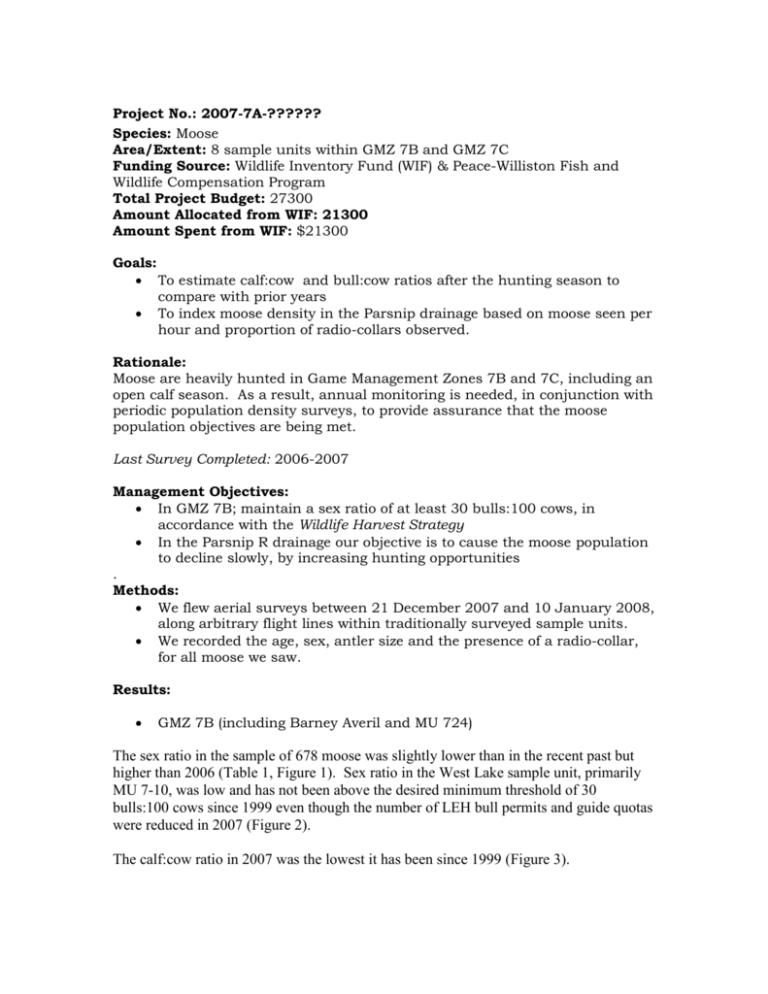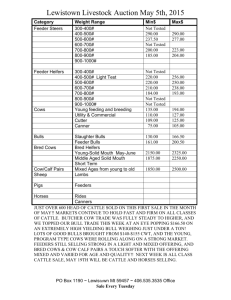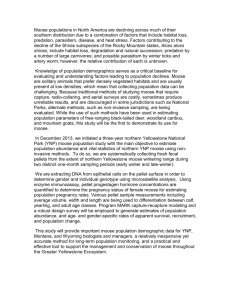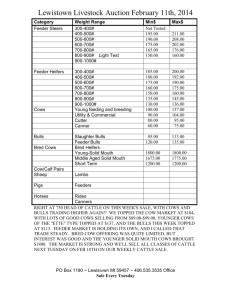
Project No.: 2007-7A-??????
Species: Moose
Area/Extent: 8 sample units within GMZ 7B and GMZ 7C
Funding Source: Wildlife Inventory Fund (WIF) & Peace-Williston Fish and
Wildlife Compensation Program
Total Project Budget: 27300
Amount Allocated from WIF: 21300
Amount Spent from WIF: $21300
Goals:
To estimate calf:cow and bull:cow ratios after the hunting season to
compare with prior years
To index moose density in the Parsnip drainage based on moose seen per
hour and proportion of radio-collars observed.
Rationale:
Moose are heavily hunted in Game Management Zones 7B and 7C, including an
open calf season. As a result, annual monitoring is needed, in conjunction with
periodic population density surveys, to provide assurance that the moose
population objectives are being met.
Last Survey Completed: 2006-2007
Management Objectives:
In GMZ 7B; maintain a sex ratio of at least 30 bulls:100 cows, in
accordance with the Wildlife Harvest Strategy
In the Parsnip R drainage our objective is to cause the moose population
to decline slowly, by increasing hunting opportunities
.
Methods:
We flew aerial surveys between 21 December 2007 and 10 January 2008,
along arbitrary flight lines within traditionally surveyed sample units.
We recorded the age, sex, antler size and the presence of a radio-collar,
for all moose we saw.
Results:
GMZ 7B (including Barney Averil and MU 724)
The sex ratio in the sample of 678 moose was slightly lower than in the recent past but
higher than 2006 (Table 1, Figure 1). Sex ratio in the West Lake sample unit, primarily
MU 7-10, was low and has not been above the desired minimum threshold of 30
bulls:100 cows since 1999 even though the number of LEH bull permits and guide quotas
were reduced in 2007 (Figure 2).
The calf:cow ratio in 2007 was the lowest it has been since 1999 (Figure 3).
GMZ 7C - Parsnip drainage
The sex ratio of 36 bulls:100 cows was well below the long term average of about 80
bulls:100 cows, but a bit higher than 2006 (Figure 4). The number of calves per 100 cows
was by far the lowest ever recorded, at only 6 calves: 100 cows, (n=133 cows and 8
calves; Table 1, Figure 5). Usually there are between 20 and 30 calves: 100 cows.
Moose numbers appear to have declined to about 70% of what they were 2 years ago
based on 1) the number of moose seen on the survey 190 vs a mean of 270, and 2) seeing
2 of 23 radio collared moose yielding a population estimate of 2200 moose (190/[2/23])
vs the 2005 estimate of 3000 moose. There are no comparable prior data for a north
south division but on this survey only 1 of 8 calves and 25% of the total moose were in
the southern third of the drainage (Missinka R to Arctic Lake).
Potential Biases: When we collared 23 cow moose in 26 November to 12 December
2007, all were in open cutblocks. By 24 January 2008, 86% (19 of 22) of those moose
were in the forest. We usually count the Parsnip in late December but we counted on 7
January 2008. The low Parsnip count and calf:cow ratio could have been biased if <30%
of the moose had moved from the open cutblocks to the forest by 7 January 2008. The
calf:cow ratio would be underestimated if cows with calves were the first to move into
the forest. On 24 January, 5 five of the 22 radio-collared cows had a calf for an estimate
of 23 calves: 100cows.
Table 1. Number of moose classified in 6 sampling areas around Prince George and in the
Parsnip drainage in December 2007 and January 2008.
Sample
Number of moose
Bulls:
Calves:
area & MU
Bulls Cows Calves
Total
100 cows
100 cows
________________________________________________________________________
West Lake 710
Bowron River 707
Grove Burn 709
Barney Averil 716
Mud River 712B
MU 715
MU 724
Totals
Parsnip 723 & 716
South
North
Totals
15
73
3
5
17
11
36
70
149
5
12
71
37
71
24
27
1
0
20
11
20
109
249
9
17
108
59
127
21
42
60
42
24
30
51
34
18
20
0
28
30
28
160
415
103
678
39
25
10
39
37
96
1
7
48
142
27
41
3
7
49
133
8
190
37
6
________________________________________________________________________
Management Implications:
In general, the current level of hunting pressure on moose in GMZ 7B appears
to be sustainable. Continued monitoring is required to assess the effect on the
sex ratio MU 7-10, of the reduced bull moose LEH authorizations and guide
quotas made in 2007.
Even though the number of moose in the Parsnip drainage appears to be
declining at an acceptable rate overall, LEH permits will be shifted within the
MU subzones (from 7-23D & E in the south to 723-A B & C in the north) to
compensate for the low calf:cow ratio and low density of moose in the southern
part of the drainage .
Figure 1.
GMZ 7B Bulls:100 Cows (excluding West Lake)
50
45
40
35
30
25
20
15
10
5
0
1998
2000
2002
2004
2006
2008
Figure 2.
Bulls: 100 Cows at West Lake
30
25
20
15
10
5
0
1998
2000
2002
2004
2006
Figure 3.
GMZ 7B Calves:100 Cows
40
35
30
25
20
15
10
5
0
1998
2000
2002
2004
2006
2008
2008
Figure 4.
Parsnip Bulls:100 Cows by Year
140.0
120.0
100.0
80.0
60.0
40.0
20.0
0.0
1998
2000
2002
2004
2006
2008
Figure 5.
Parsnip Calves:100 Cows by Year
35.0
30.0
25.0
20.0
15.0
10.0
5.0
0.0
2002
2003
2004
2005
2006
2007
2008






